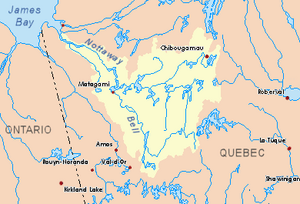Saint-Cyr River facts for kids
Quick facts for kids Saint-Cyr |
|
|---|---|

Watershed of Nottaway River
|
|
| Country | Canada |
| Province | Quebec |
| Region | Nord-du-Québec |
| Physical characteristics | |
| Main source | Barry Lake (Saint-Cyr River South) Eeyou Istchee James Bay (municipality), Nord-du-Québec, Quebec 395 m (1,296 ft) 49°00′31″N 75°34′23″W / 49.00861°N 75.57306°W |
| River mouth | Mégiscane River Eeyou Istchee James Bay (municipality), Nord-du-Québec, Quebec 338 m (1,109 ft) 49°19′12″N 75°18′42″W / 49.32000°N 75.31167°W |
| Length | 48.9 km (30.4 mi) |
| Basin features | |
| Tributaries |
|
The Saint-Cyr River is a river in Quebec, Canada. It flows into Doda Lake. This lake is part of the larger Nottaway River system. The river is located in the Nord-du-Québec region, specifically in the area called Jamésie.
The Saint-Cyr River flows through several townships, including Urban, Lacroix, Belmont, and Royal. The main activity in this area is forestry, which means cutting down trees for wood. Tourism, like fishing or camping, is also popular.
A forest road, R1053, runs near the river. It helps people get around the area. Another road, R1009, connects to it. The river usually freezes over in early November. It stays frozen until mid-May, making it safe for ice travel from mid-November to mid-April.
Contents
Exploring the Saint-Cyr River's Path
The Saint-Cyr River is surrounded by other rivers and lakes. These are called its hydrographic slopes. Think of them as neighboring water bodies.
Where Does the Saint-Cyr River Start?
The Saint-Cyr River begins at Barry Lake (Saint-Cyr River South). This lake is about 12.9 kilometers (8 miles) long. It sits at an elevation of 392 meters (1,286 feet). The lake is located in the townships of Barry and Bailly.
The start of the Saint-Cyr River is:
- 39.5 kilometers (24.5 miles) south of where it joins Doda Lake.
- 53.8 kilometers (33.4 miles) southeast of the mouth of Doda Lake.
- 80.6 kilometers (50.1 miles) southeast of where the Opawica River and Chibougamau River meet. This meeting point forms the start of the Waswanipi River.
- 348 kilometers (216 miles) southeast of the mouth of the Nottaway River, which flows into James Bay.
How Long is the Saint-Cyr River?
From Barry Lake (Saint-Cyr River South), the Saint-Cyr River flows for 48.9 kilometers (30.4 miles). It travels in a generally northeast direction.
Here's how its path unfolds:
- It flows 5.9 kilometers (3.7 miles) northeast to the edge of Lacroix township.
- Then, it continues 4.7 kilometers (2.9 miles) northeast within Lacroix township.
- Next, it goes 13.4 kilometers (8.3 miles) northeast in Belmont Township.
- It travels 8.5 kilometers (5.3 miles) northeast past Hébert Lake (Hébert River).
- It flows 6.6 kilometers (4.1 miles) northeast in Royal Township.
- Finally, it goes 9.8 kilometers (6.1 miles) northeast to its mouth.
Where Does the Saint-Cyr River End?
The Saint-Cyr River flows into a bay on the south shore of Doda Lake. This bay stretches for about 1.2 kilometers (0.7 miles). The northern part of Doda Lake is crossed by the Opawica River.
The Opawica River then flows west through several lakes. These include Françoise Lake (Opawica River), La Ronde Lake, Lessard Lake, and Lichen Lake (Opawica River). It then goes north through Wachigabau Lake and Opawica Lake. Finally, it meets the Chibougamau River, forming the Waswanipi River.
The Waswanipi River flows west through Lake Waswanipi, Goéland Lake, and Olga Lake. It then empties into Matagami Lake. From there, the water flows into the Nottaway River, which eventually reaches Rupert Bay in James Bay.
The meeting point of the Saint-Cyr River with the Opawica River is:
- 15.1 kilometers (9.4 miles) south of the mouth of Doda Lake.
- 63.5 kilometers (39.5 miles) southeast of where the Opawica River meets the Chibougamau River.
- 95.1 kilometers (59.1 miles) southwest of downtown Chibougamau.
- 62.1 kilometers (38.6 miles) southwest of the village of Chapais.
- 77.6 kilometers (48.2 miles) northwest of the village of Obedjiwan.
- 338.4 kilometers (210.3 miles) southeast of the mouth of the Nottaway River.
The Name of the Saint-Cyr River
The name "Saint-Cyr" comes from a French family name.
Who Lived Here Before?
Over time, different Indigenous peoples have lived in this area. These include the Attikameks, the Algonquins, and the Crees.
Why is it Called Saint-Cyr?
In the late 1800s, a surveyor named Henry O'Sullivan explored this region. He named the river "Saint-Cyr River" to honor his assistant, Arthur Saint-Cyr (1860-1923). Arthur Saint-Cyr worked with O'Sullivan from 1879 to 1886. He later helped build the Quebec Central Railway.
The name "Saint-Cyr River" was officially recognized on December 5, 1968. This happened when the Commission de toponymie du Québec (Quebec's Place Names Commission) was created.
The Two Parts of the Saint-Cyr River
The Saint-Cyr River actually has two parts. The southern part, starting from Barry Lake (Saint-Cyr River South), flows towards the Mégiscane River. This river is part of the Nottaway River system.
The northern part, which is 48.9 kilometers (30.4 miles) long, flows towards the Opawica River. This means the river's water flows in two different directions, into two different river systems! Because of this, the southern part was officially renamed "Rivière Saint-Cyr Sud" (South Saint-Cyr River) on September 24, 2003. The name "Saint-Cyr River" now refers only to the northern section.

